Southwestern kitchens capture the rugged beauty and vibrant spirit of the American Southwest, blending earthy materials, bold colors, and artisanal craftsmanship. These spaces celebrate adobe-inspired textures, terracotta hues, and handcrafted accents, resulting in kitchens that feel warm, inviting, and richly layered. Whether you’re embarking on a full remodel or refreshing select elements, these twenty ideas will help you infuse your kitchen with authentic Southwestern flair, from earth-toned palettes and decorative tilework to rustic wood beams and lively textiles. Each concept embraces the region’s heritage, drawing on Pueblo Revival and Spanish Mission influences to create kitchens that are as functional as they are soulful.
1. Incorporating Earth-Toned Color Palettes
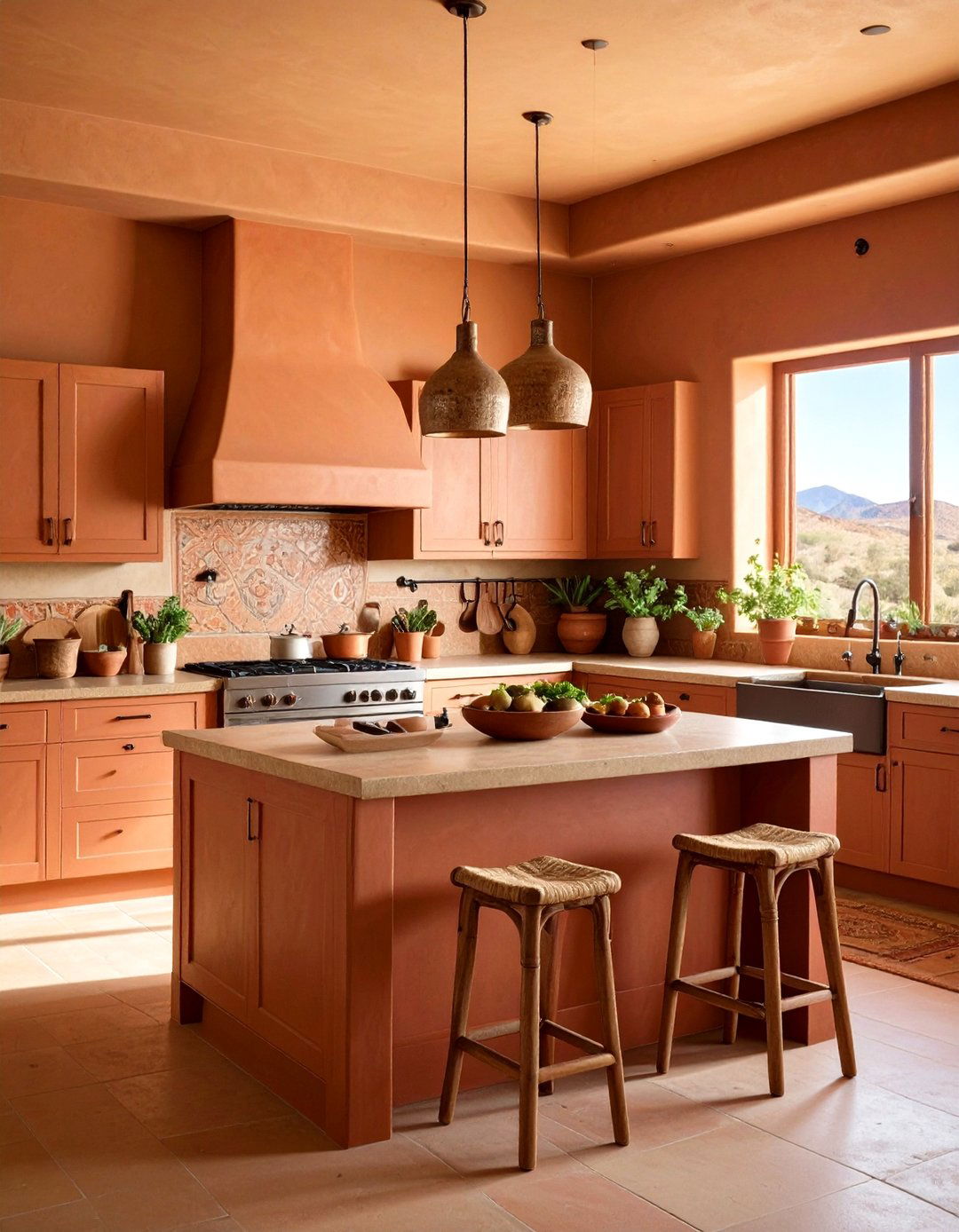
A hallmark of Southwestern design is its grounding, earthy color scheme—think warm terracotta, muted turquoise, sunbaked ochre, and adobe brown. Painting cabinetry or walls in these hues instantly evokes desert landscapes while providing a serene backdrop for brighter accents. Lighter tones like sandy beige can make small kitchens feel more spacious, whereas deeper rusts and coppers bring drama and warmth. Pairing two complementary earth tones—for example, a clay-red island against a golden-beige perimeter—creates depth and visual interest. This palette allows natural materials like wood and stone to shine, reinforcing the organic, handcrafted vibe of Southwestern style.
2. Embracing Adobe and Stucco Textures
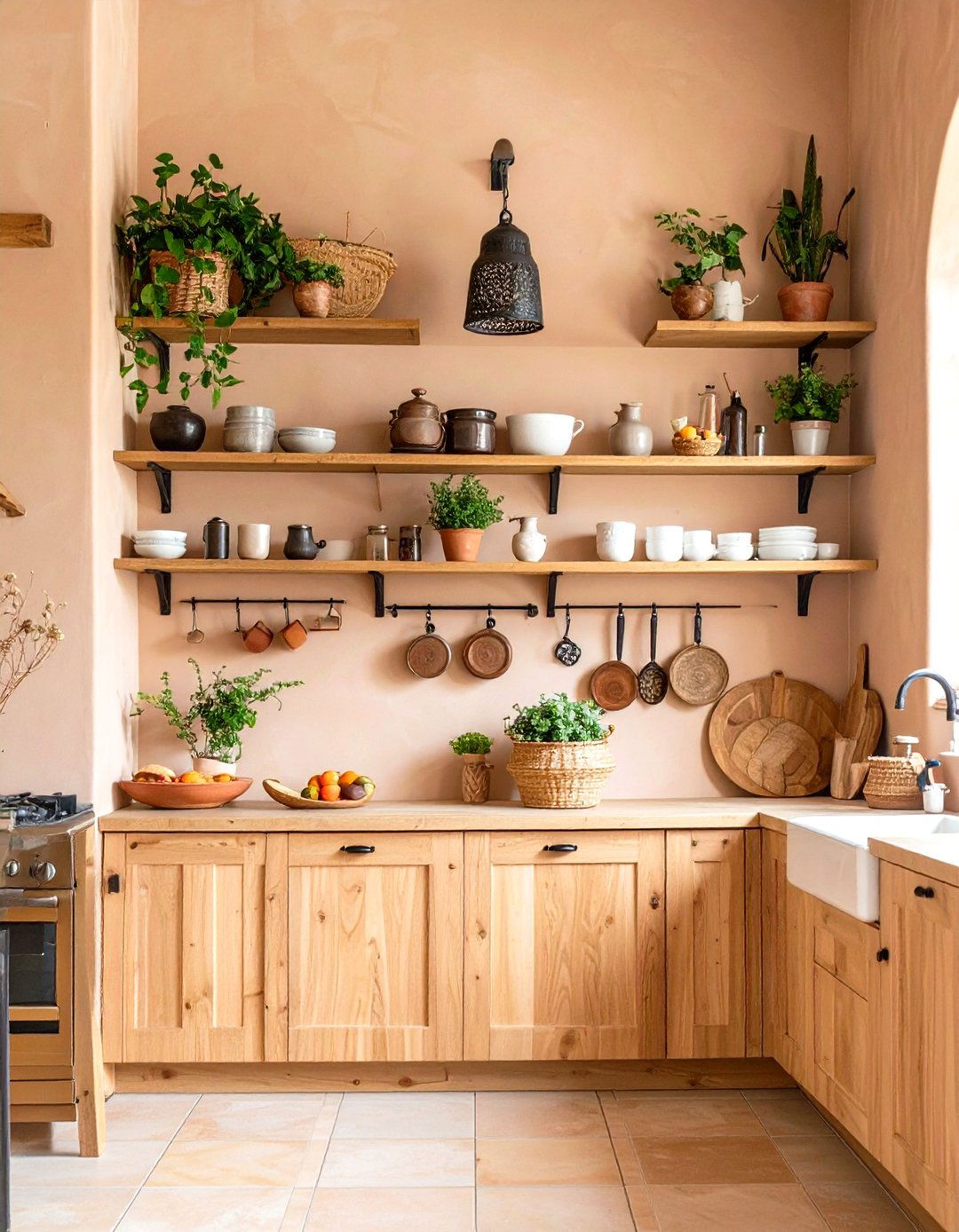
Textured walls and surfaces mimic traditional adobe construction, lending authenticity and tactile appeal. Plaster or stucco finishes, applied by hand, produce subtle undulations and imperfections characteristic of Southwestern adobe homes. You can incorporate these textures on countertops, backsplashes, or even the kitchen island. Exposed plaster under open shelves or around a cooking nook softens transitions between materials and highlights handcrafted artistry. An adobe-style hood over the range becomes a sculptural focal point, blending functionality with regional character. These finishes pair seamlessly with wrought-iron fixtures and wooden accents for a cohesive Southwestern look.
3. Showcasing Decorative Tilework
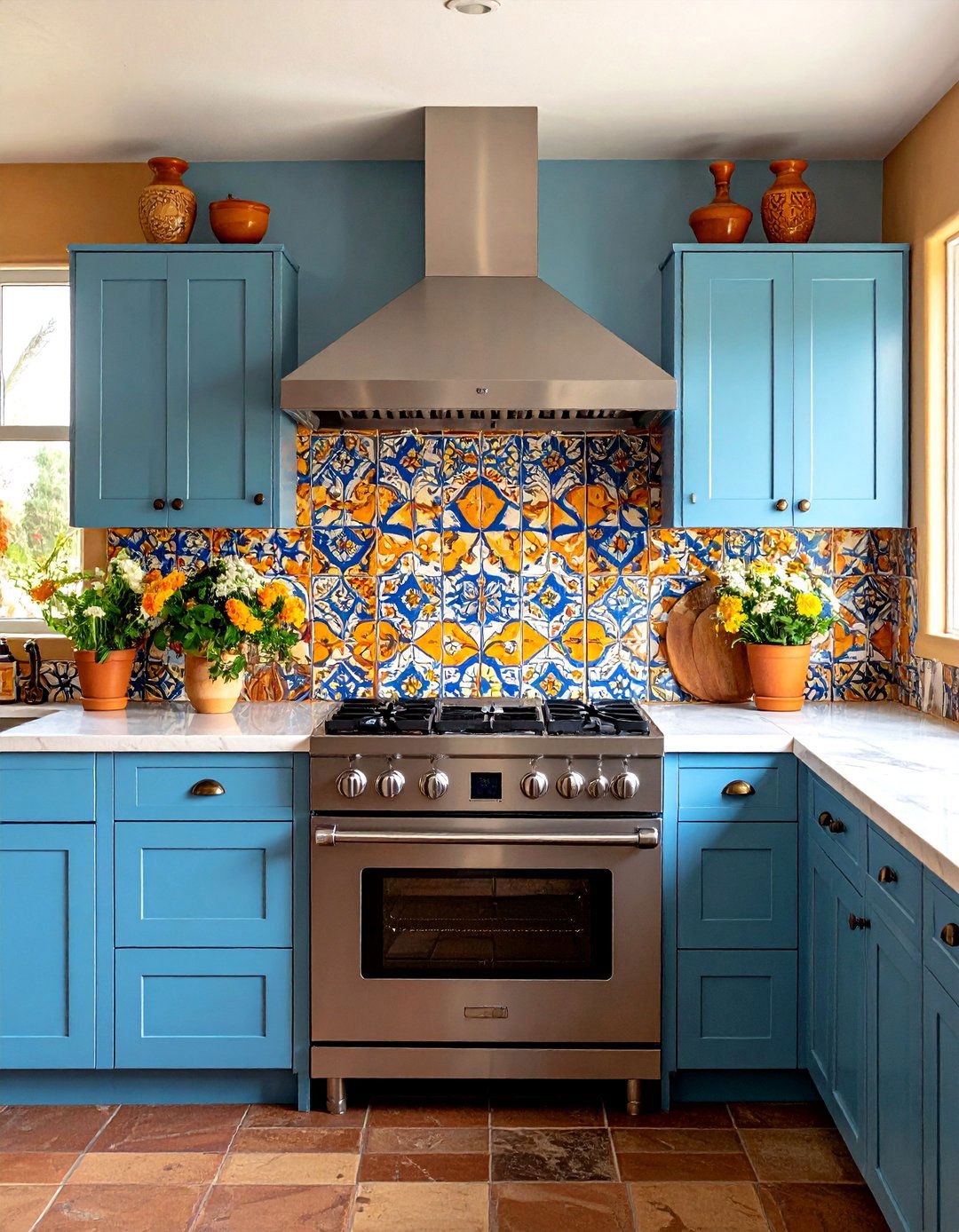
Southwestern kitchens often feature vibrant tile patterns inspired by Mexican Talavera or Spanish Colonial traditions. Use hand-painted ceramic tiles as a colorful backsplash, on the face of an island, or to frame the stovetop. Geometric motifs in blues, oranges, and yellows add lively contrast against earth-toned cabinetry. Terracotta tile floors with decorative insets can define work zones and walkways. For a more subtle approach, opt for tile borders along countertops or around windows. The combination of rustic, handcrafted tiles with contemporary appliances bridges traditional craftsmanship and modern convenience.
4. Layering Textiles and Patterns
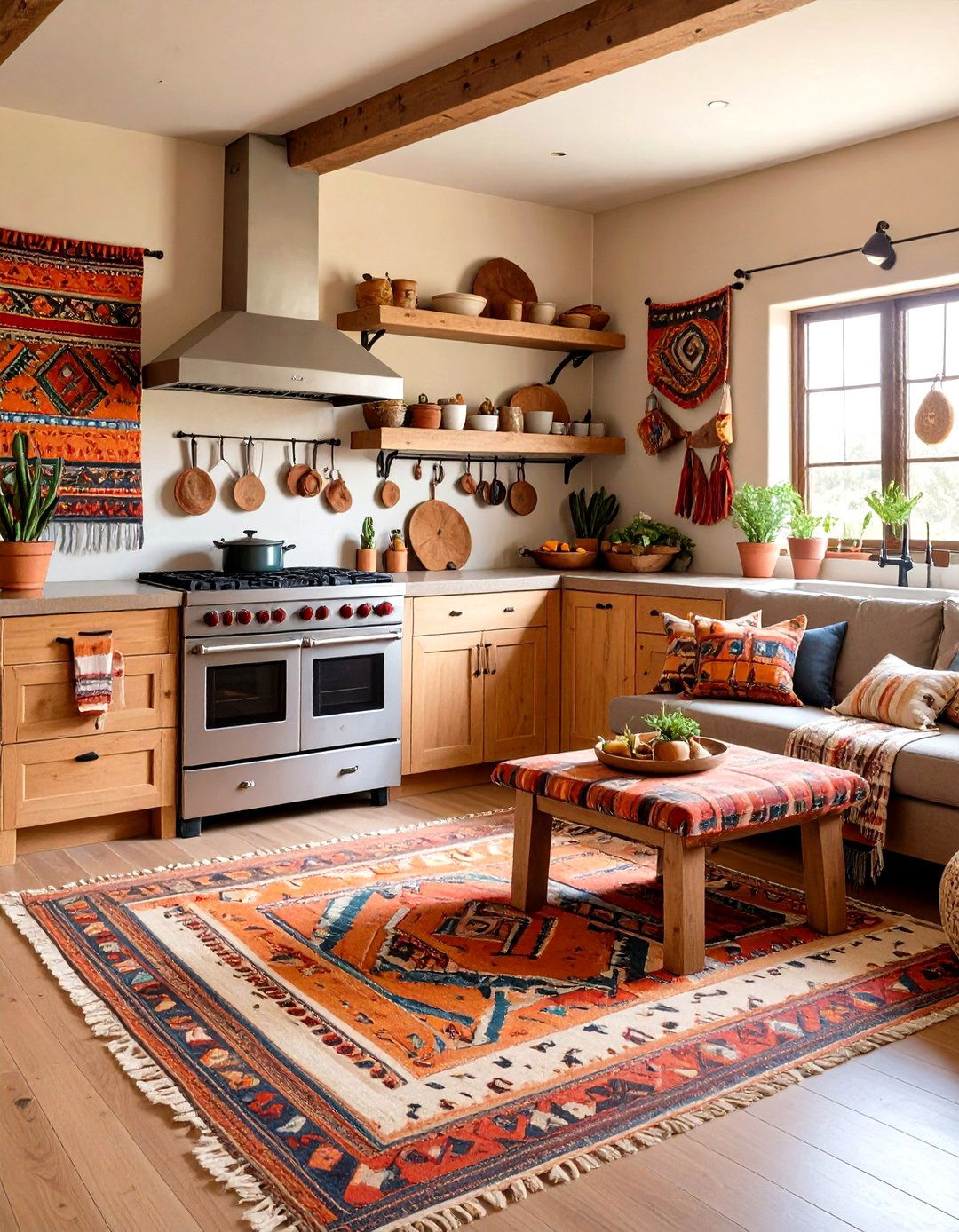
Textiles—rugs, runner mats, seat cushions, and window treatments—infuse Southwestern kitchens with warmth and color. Look for wool or jute rugs featuring Navajo-inspired patterns, stripes, or checkerboard designs in terracotta, turquoise, and chocolate. Handwoven tapestries hung on walls or draped over banquette backs introduce artisanal flair. Accent pillows in ikat or diamond motifs soften seating areas and echo the tilework’s geometry. These layers of pattern and texture invite touch and visual exploration, enhancing the kitchen’s cozy, lived-in atmosphere.
5. Highlighting Natural Wood Elements
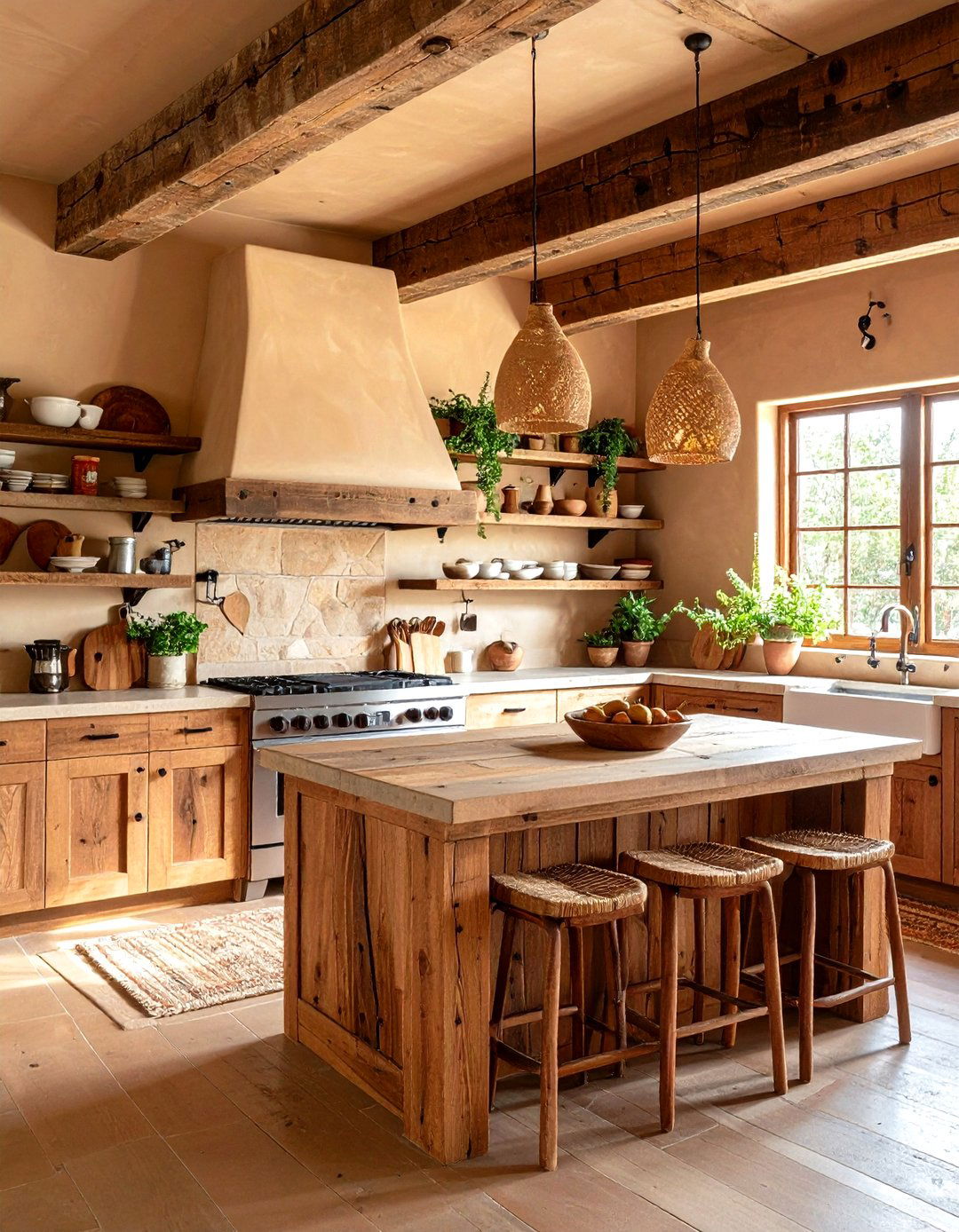
Unfinished or lightly stained wood beams, cabinetry, and open shelving bring organic warmth to Southwestern kitchens. Rustic vigas (exposed ceiling beams) pay homage to traditional Pueblo Revival architecture while visually expanding the space. Reclaimed wood shelving displays pottery, woven baskets, and spice jars, adding both storage and style. For cabinetry, choose knotty alder or mesquite wood with simple recessed panels to maintain a handcrafted feel. Wooden countertops or butcher-block islands offer a tactile counterpoint to tile and stone surfaces, reinforcing the kitchen’s natural material palette.
6. Integrating Open Shelving

Open shelving replaces upper cabinets to showcase pottery, glassware, and decorative accents. Rust-colored clay pots, turquoise vases, and hand-painted plates become part of the kitchen’s decor. Shelves constructed from reclaimed wood or iron brackets align with the style’s artisanal roots. This approach lightens the visual weight of cabinetry, making smaller kitchens feel airy and open. Experiment with asymmetrical layouts—long lower shelves coupled with stacked cubbies create dynamic vignettes for display.
7. Installing Statement Lighting Fixtures
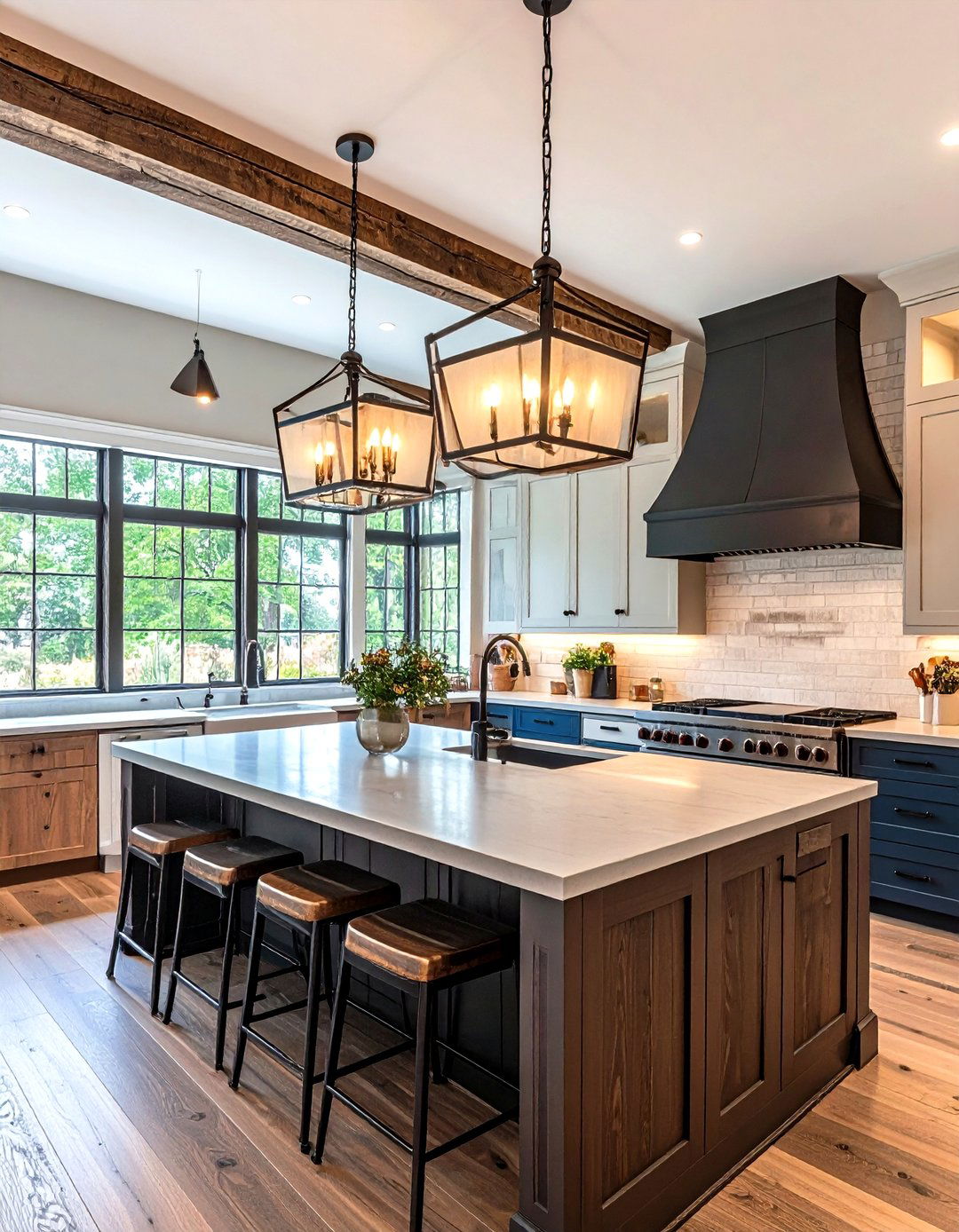
Lighting shapes ambiance and highlights key design elements. Wrought-iron chandeliers or pendant lights with lantern silhouettes complement the rustic aesthetic. For a softer glow, choose fixtures with frosted glass panels or hand-blown glass shades in amber or milk-white. Track lighting with adjustable iron spotlights can illuminate artwork or tilework, while under-cabinet LED strips discreetly brighten countertops. Layered lighting—ambient, task, and accent—ensures both functionality and mood, crucial for a kitchen that serves as both workspace and gathering place.
8. Adding Terracotta Accents
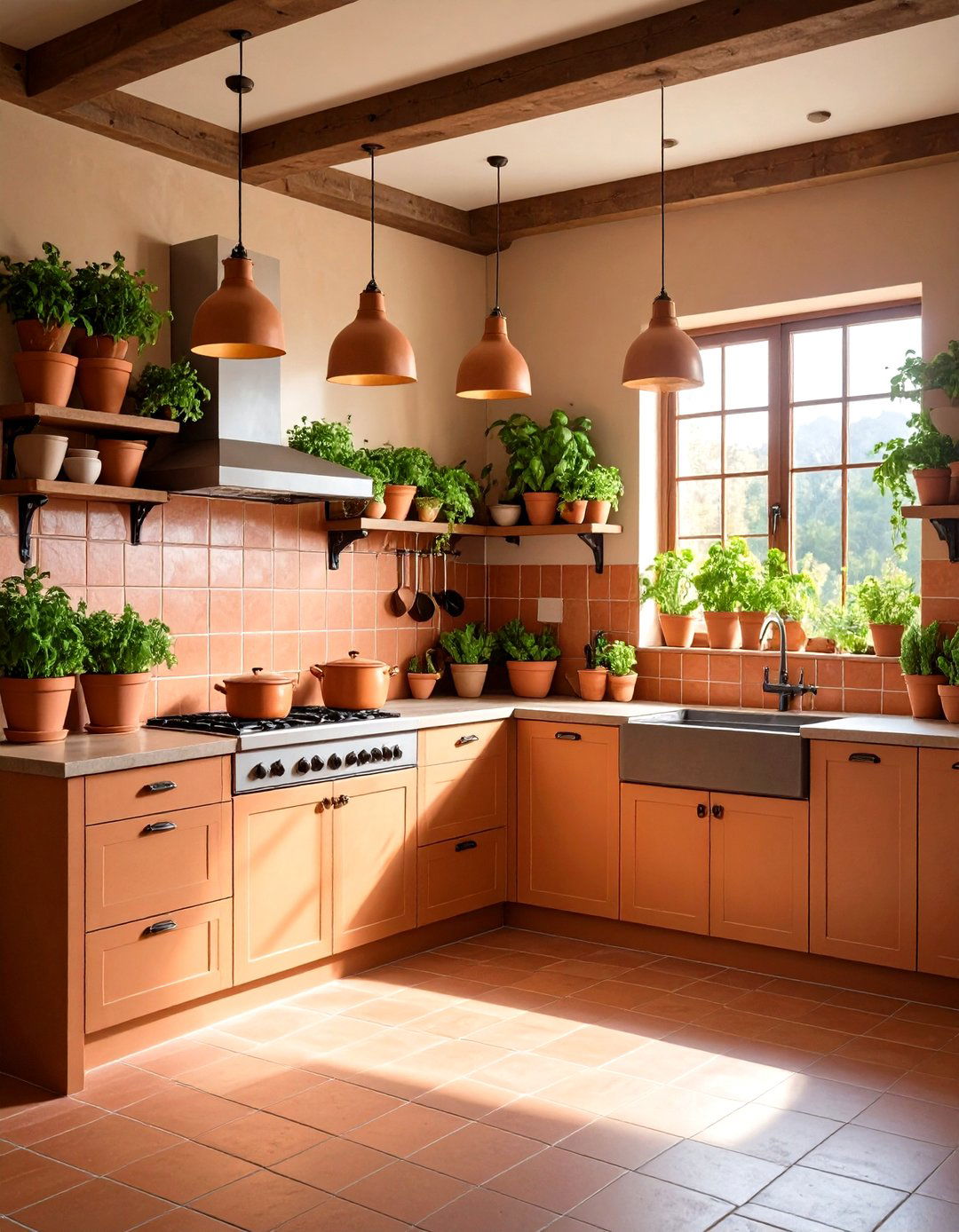
Terracotta is synonymous with Southwestern kitchens. From floor tiles to decorative accessories, its warm, earthy hue anchors the room. Incorporate terracotta pots for fresh herbs, a tile countertop border, or individual terracotta trivets set into concrete countertops. Even terracotta pendant lamp shades can bring a subtle, textural detail. The material’s porous nature adds tactile depth, contrasting polished metal fixtures or glossy appliances. Terracotta elements tie the kitchen back to desert landscapes and adobe architecture.
9. Incorporating Rustic Wood Beam Ceilings
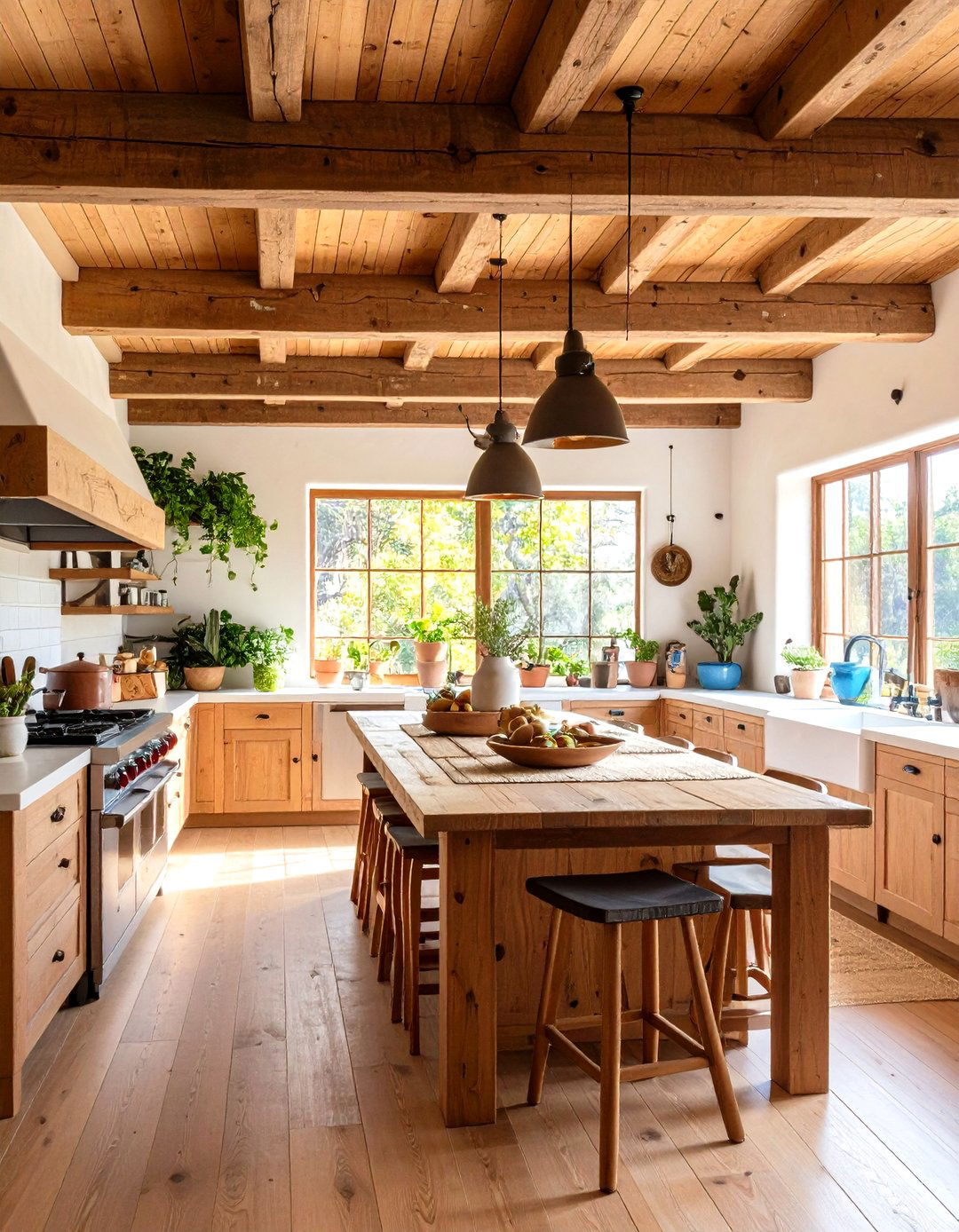
Vigas—traditional wooden beams—are both structural and decorative in Southwestern design. Installing vigas across the ceiling introduces architectural interest and historic resonance. For authenticity, source reclaimed wood with natural knots and irregularities. Pair with simple latillas (thin wooden slats) between beams for a fully immersive ceiling treatment. This overhead feature draws the eye upward, balancing heavier elements like stone or tile floors and creating a sense of shelter reminiscent of New Mexican homes.
10. Selecting Bold Backsplashes
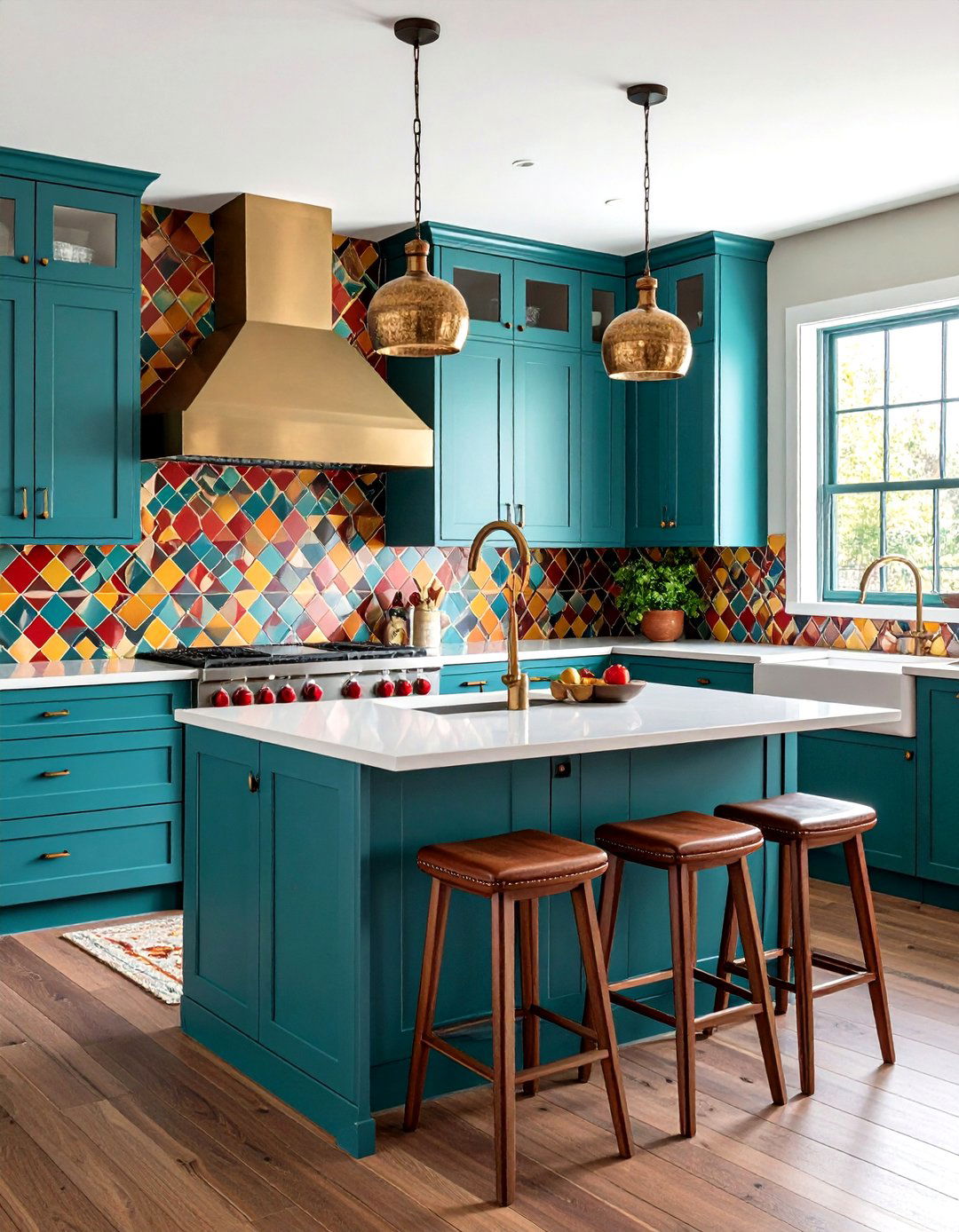
A bold backsplash dramatically contrasts neutral cabinetry and countertops. Consider colorful geometric tiles, enamel-painted metal sheets, or patterned cement tiles depicting traditional motifs. Accent behind open shelving to frame decorative items or behind the sink to protect walls from water splashes. For a modern twist, choose subway tiles in deep turquoise or oxblood red, arranged in herringbone or stacked patterns. The backsplash becomes a focal point that embodies Southwestern vibrancy.
11. Using Earthy, Textured Floors
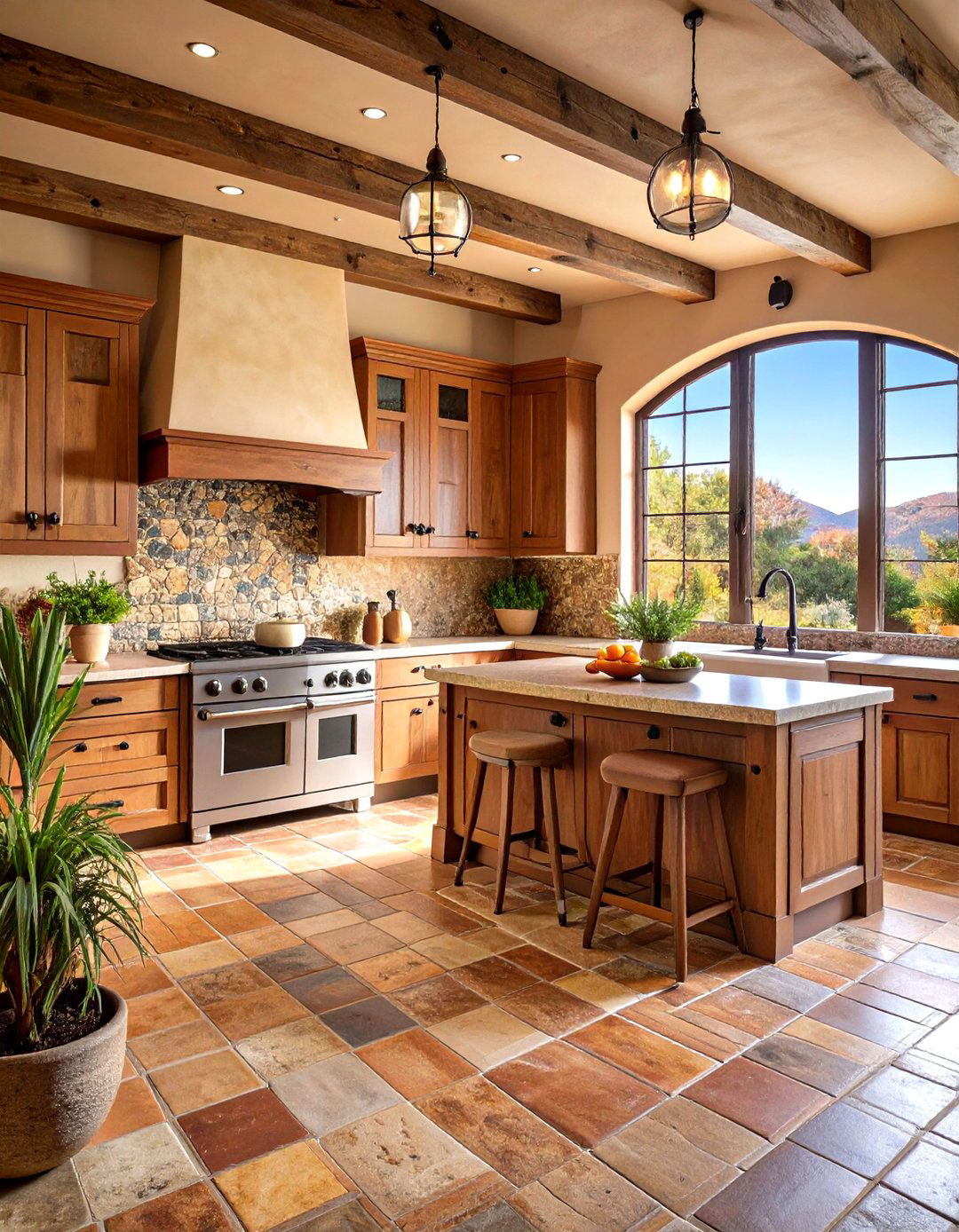
Southwestern kitchens embrace natural stone, flagstone, or terracotta tile floors with matte finishes. Saltillo tiles in varying shades of orange and red offer classic warmth. For durability and easy maintenance, consider porcelain tiles mimicking the look of hand-formed clay. Irregular edges and slight color variations in each tile enhance the handcrafted aesthetic. Stone aggregate concrete with a textured broom finish can also replicate earthen floors, providing longevity without sacrificing regional character.
12. Choosing Hand-Forged Iron Hardware
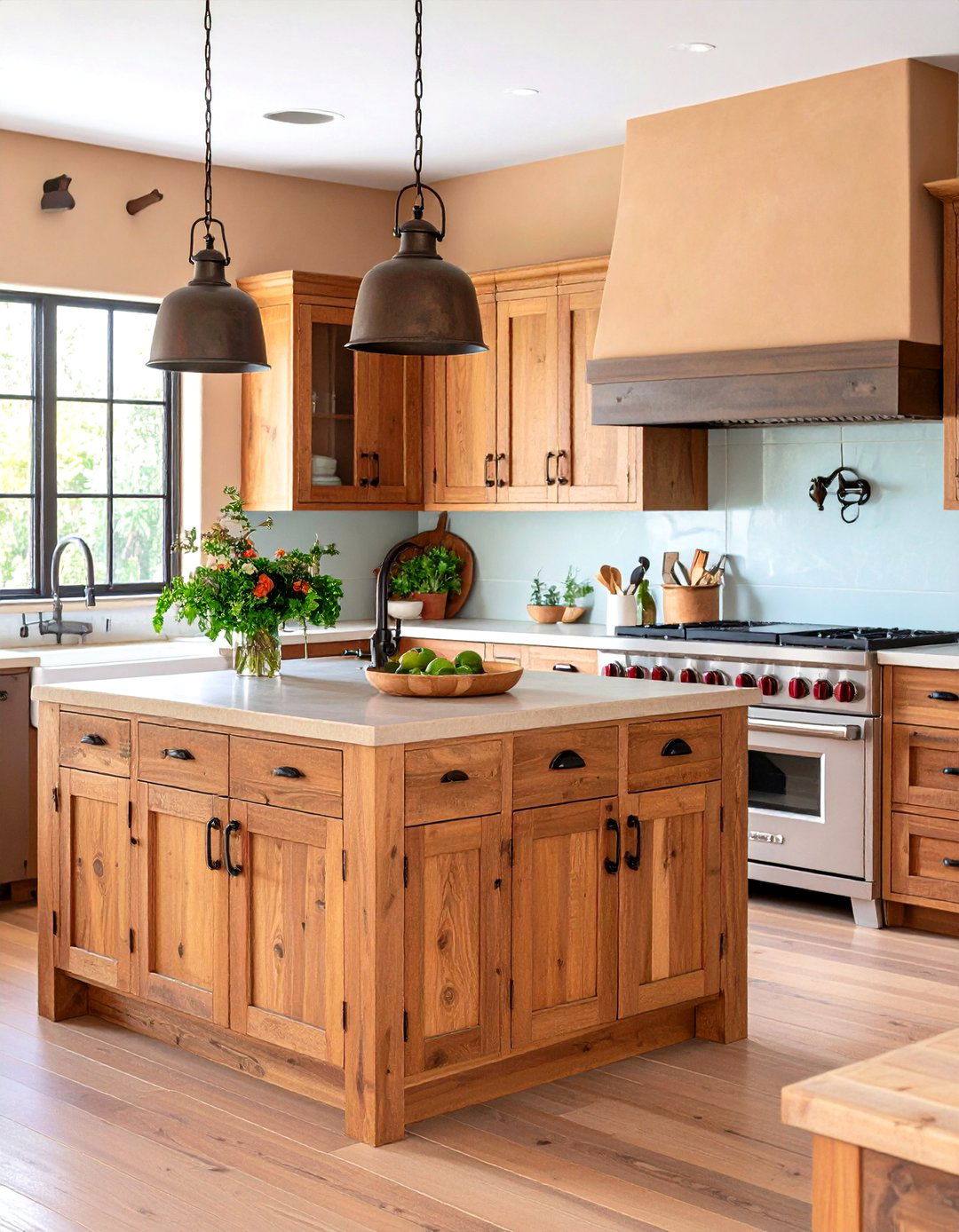
Cabinet pulls, drawer handles, and hinges in hand-forged iron or oil-rubbed bronze reinforce the artisanal quality of a Southwestern kitchen. Scrollwork designs or simple T-bar shapes both work: the former adds decorative flourish, while the latter emphasizes rustic simplicity. Iron hardware contrasts beautifully with lighter cabinetry, drawing attention to custom millwork and reinforcing the handcrafted narrative throughout the kitchen.
13. Displaying Desert-Inspired Artwork

Art prints, framed textiles, or talavera plates depicting cacti, desert sunsets, or Native American patterns add personality. Hang large-scale canvases above the dining nook or lean framed artwork on open shelves. Choose pieces with bold terracotta, turquoise, and mustard hues to coordinate with your palette. These artworks bridge interior design with regional landscape, celebrating the Southwest’s natural beauty.
14. Mixing Metal Finishes

Layering metals—copper sinks, brass faucets, and wrought-iron accents—adds complexity and warmth. A hammered copper farmhouse sink becomes a kitchen centerpiece, its patina evolving over time. Brass or bronze faucets with swan-neck spouts complement the copper, while iron light fixtures and hardware ground the palette. These mixed finishes mimic Southwestern metalwork traditions and age beautifully, deepening the kitchen’s patina-rich character.
15. Creating an Indoor Herb Garden

Integrate fresh greenery and functionality with a built-in herb garden near a sunny window. Terracotta pots on a windowsill or tiered planters mounted on a stucco-finished wall offer easy access to rosemary, oregano, and cilantro. The living green contrast enlivens the earthy palette and underscores the kitchen’s organic ethos. Plus, homegrown herbs infuse everyday cooking with Southwestern flavors like epazote and cilantro.
16. Designing a Southwestern Tile Island
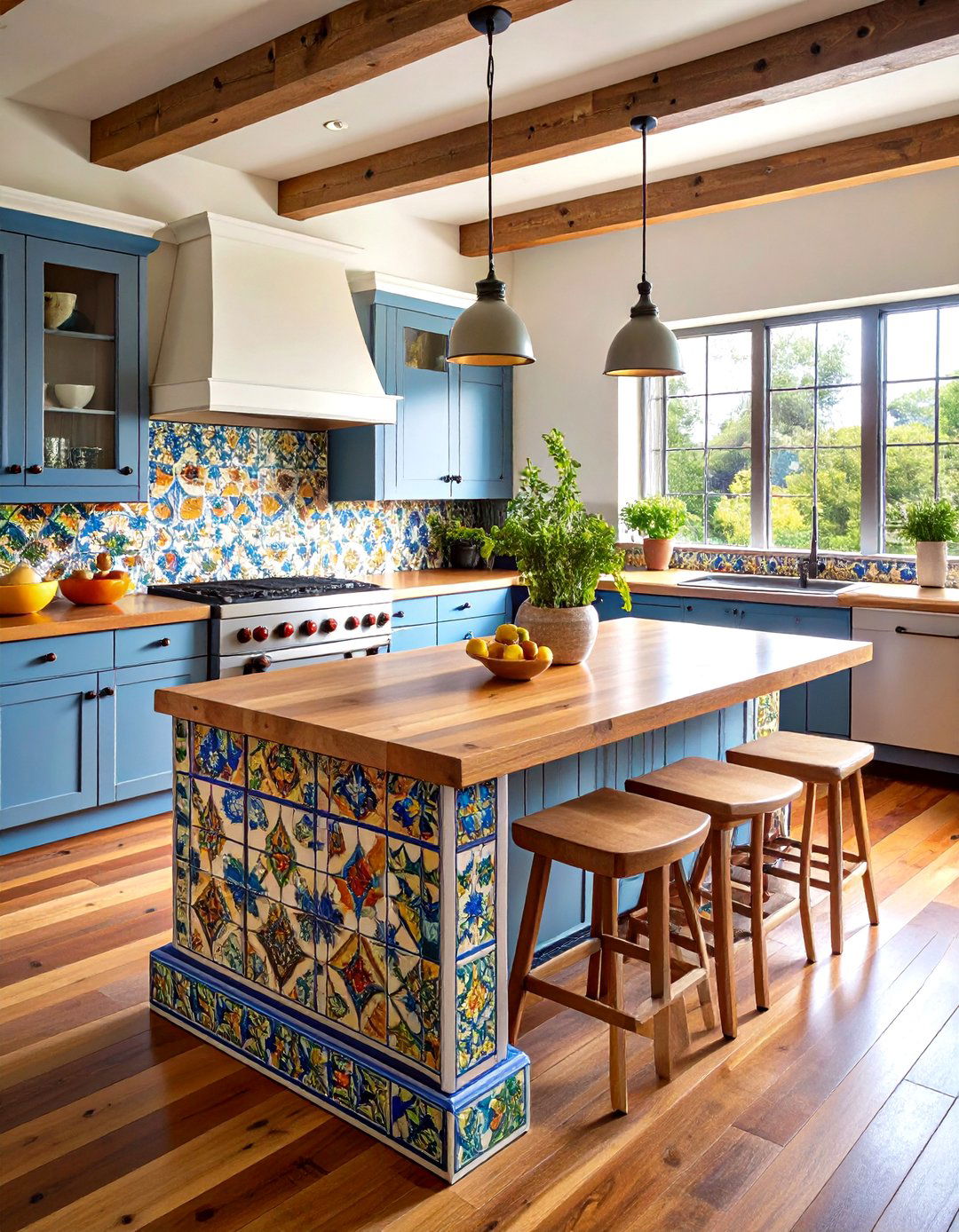
Elevate the kitchen island with full tile cladding on its base. Use patterned Talavera tiles or hand-painted ceramic mosaics to create a vibrant focal point. Pair with a simple stone or wood countertop to avoid visual overload. This technique transforms the island into a work of art, echoing the decorative tilework often found in Mexican courtyards and mission churches.
17. Infusing Pueblo Revival Architectural Elements
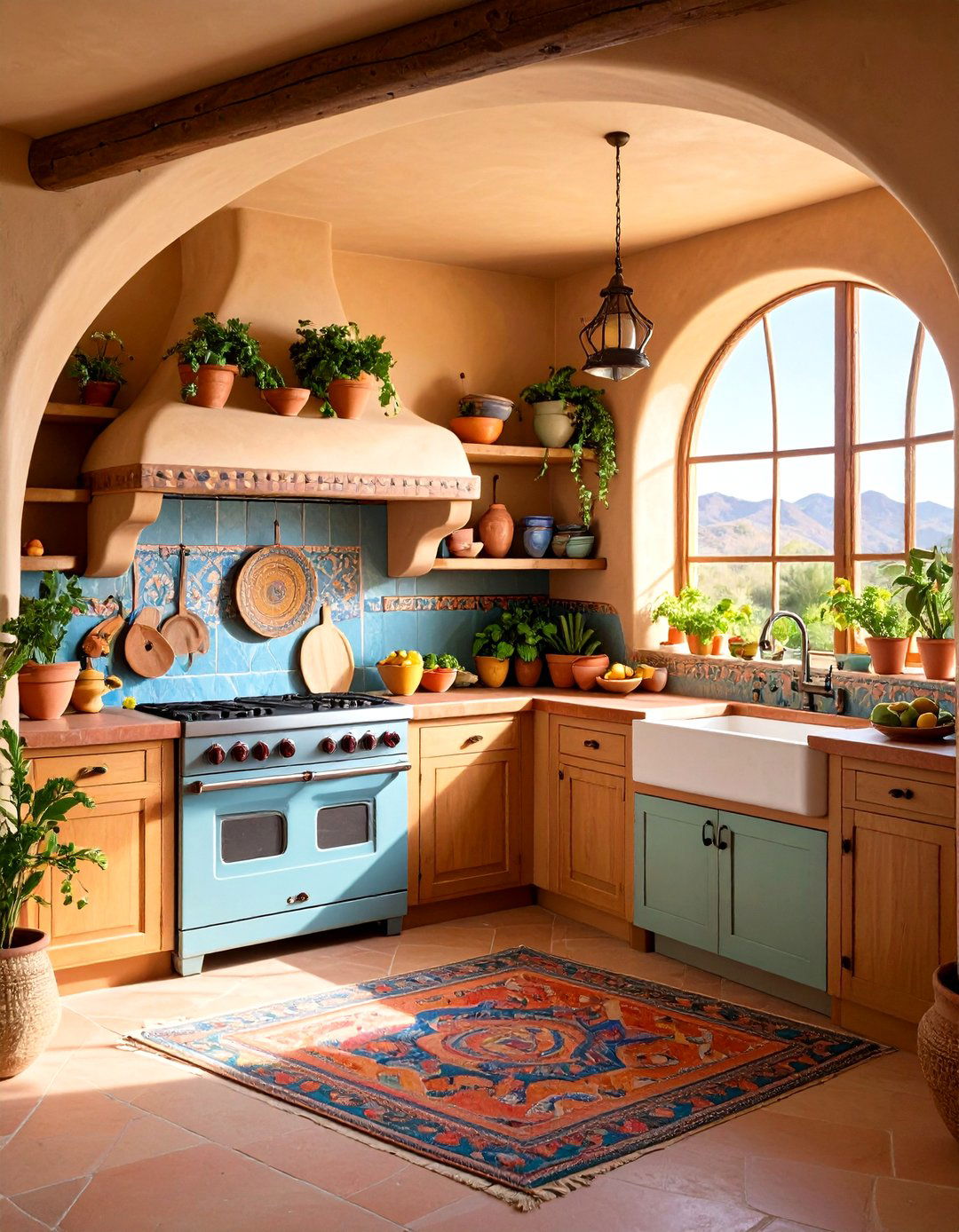
Borrow from Pueblo Revival architecture by incorporating arched doorways, rounded niches, and built-in banquettes. Rounded corners on island edges or integrated niche shelving mimic adobe structures. A rounded, plaster-clad hood above the cooktop recalls traditional vigas and thick adobe walls. These architectural details ground the kitchen in regional history while adding soft, organic forms.
18. Adding Spanish Mission Touches
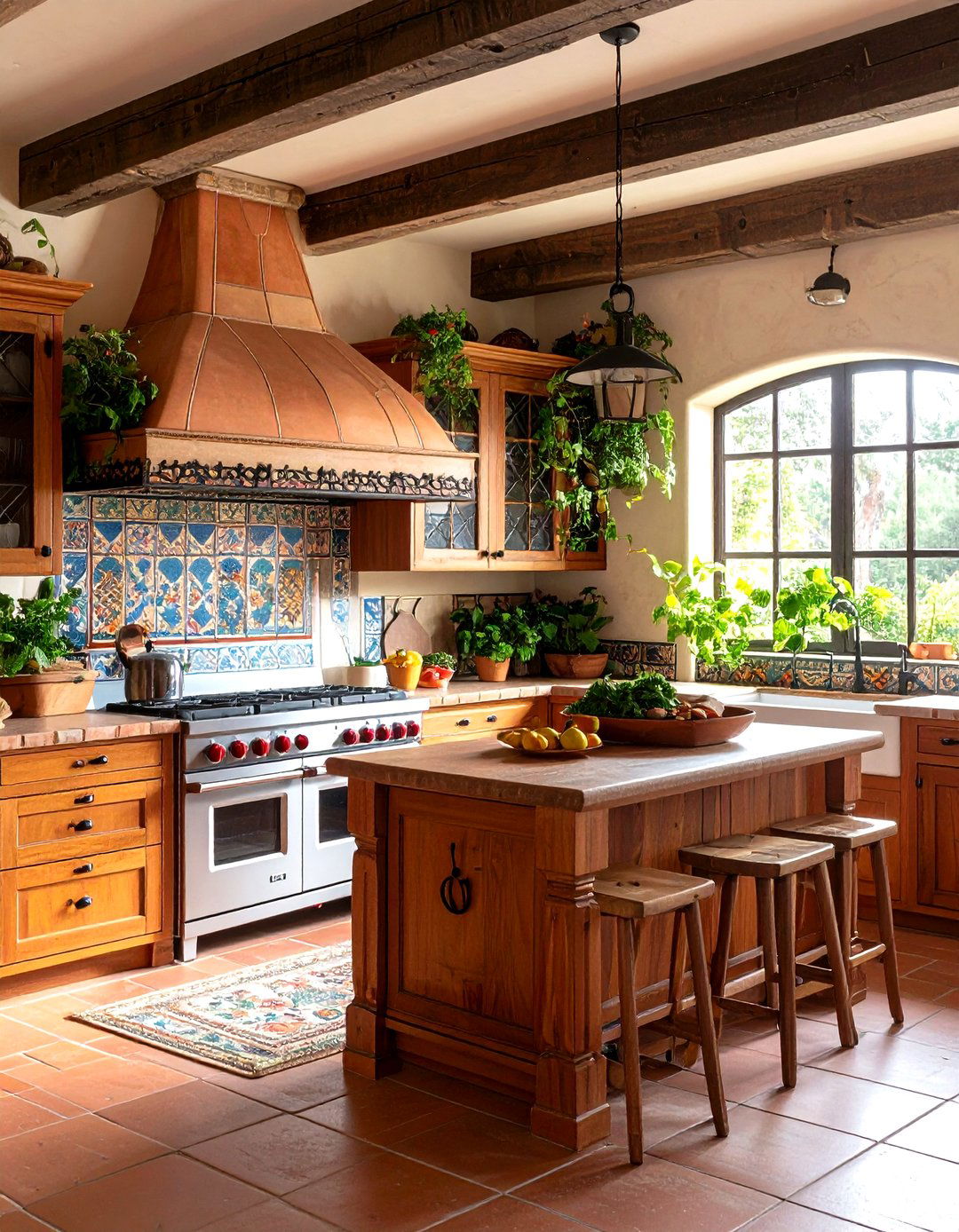
Spanish Mission style brings red barrel-tile accents and wrought-iron grilles. A hood lined with barrel tiles or a small window framed in mission tile introduces Mediterranean flair. Decorative iron grilles on cabinet doors or as window guards add both security and style. These elements pay homage to Spanish colonial missions across the Southwest.
19. Opting for Earth-Toned Cabinetry
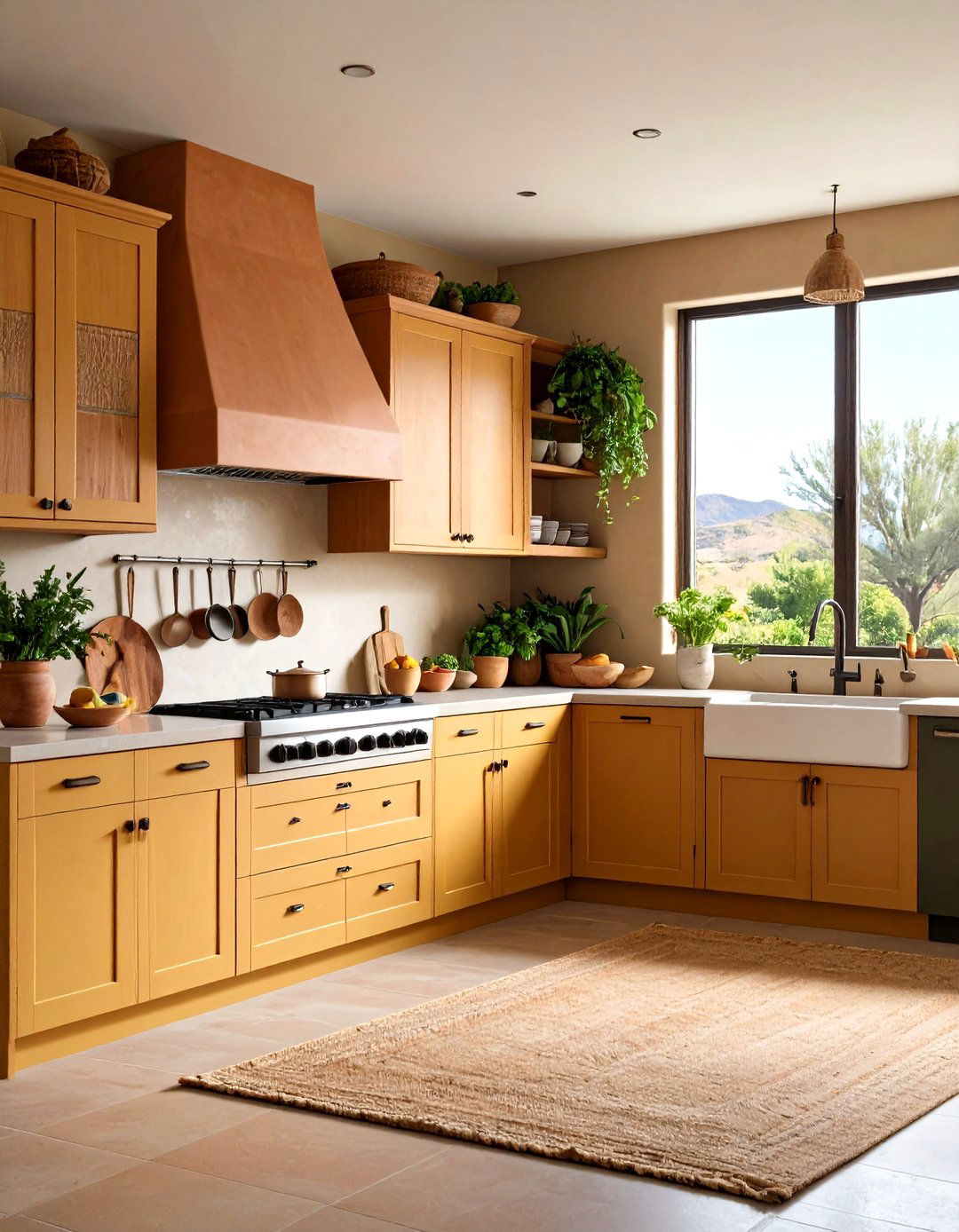
Instead of neutral whites or grays, paint cabinetry in terracotta, mustard yellow, or deep sage. Matte or satin finishes minimize glare and emphasize color depth. Pair contrasting island and perimeter cabinet colors—such as a rust island with golden-beige perimeter—to create visual layers. Earth-toned cabinetry unifies the design, reinforcing the Southwestern palette.
20. Installing a Statement Range Hood
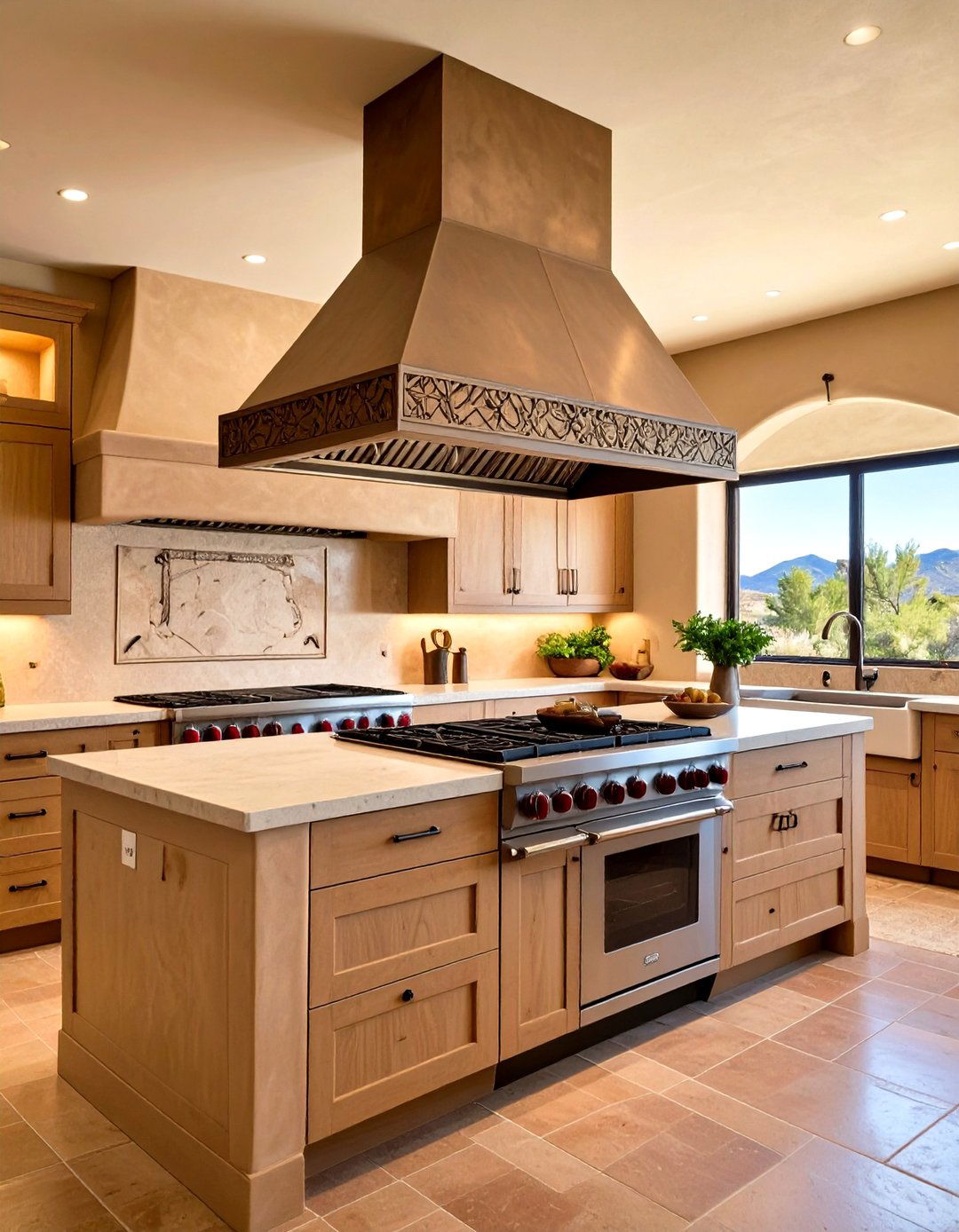
A custom range hood becomes both a functional hood and an architectural focal point. Sculpted from stucco or clad in hand-forged metal, it anchors the cooktop area. Integrate recessed niche lighting beneath the hood for subtle illumination, highlighting the vertex of your kitchen work triangle. Choose a rounded, adovelike shape to echo traditional Southwestern forms.
Conclusion:
By weaving together natural materials, earth-toned colors, handcrafted details, and architectural nods to Pueblo Revival and Spanish Mission styles, a Southwestern kitchen becomes more than a cooking space—it’s a warm, inviting reflection of desert landscapes and cultural heritage. From vibrant tilework and adobe textures to rustic wood beams and wrought-iron accents, each element contributes to a cohesive design narrative. Whether you adopt a single idea or combine several, these concepts will help you craft a kitchen that balances functionality with the soulful charm of the Southwest.


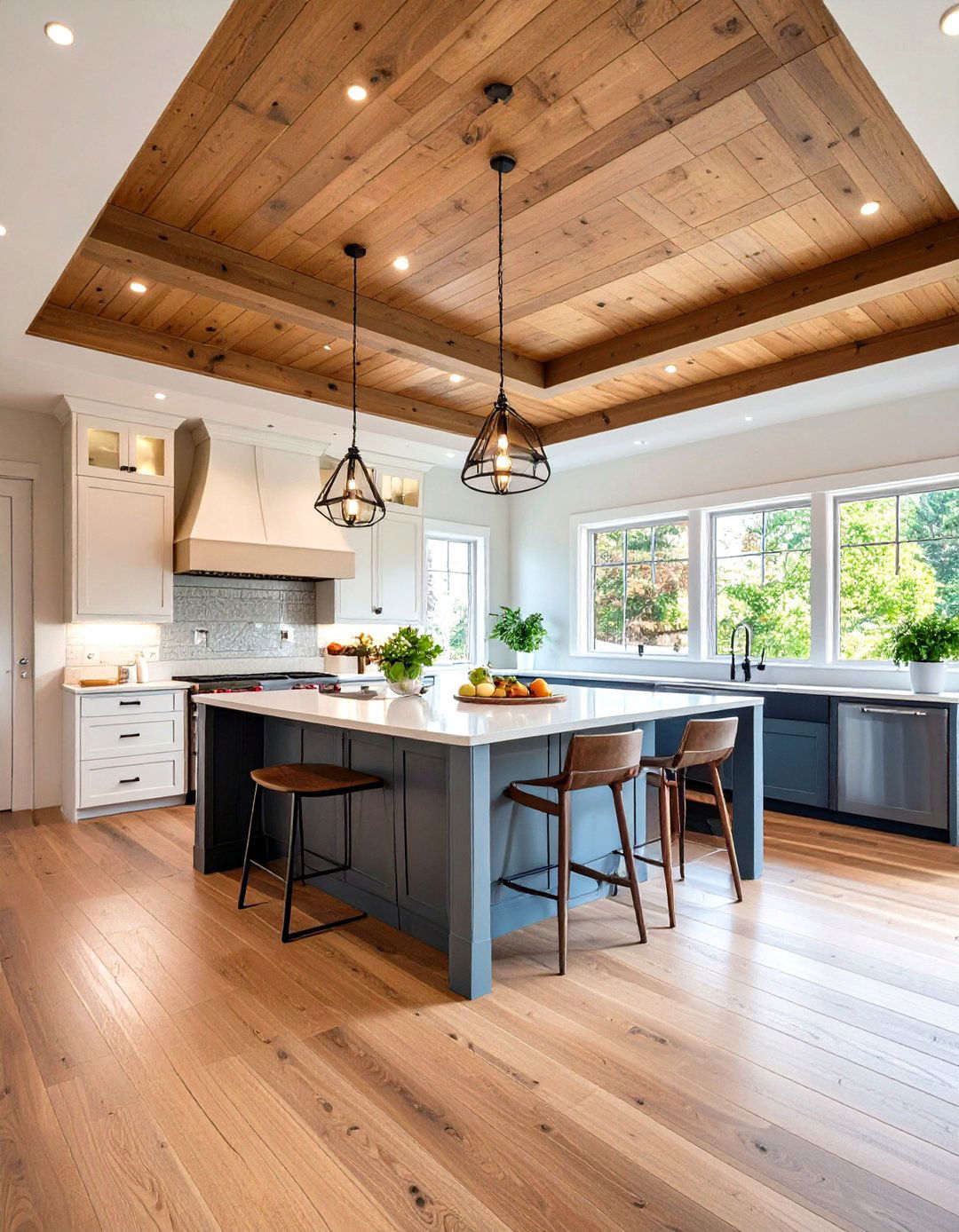
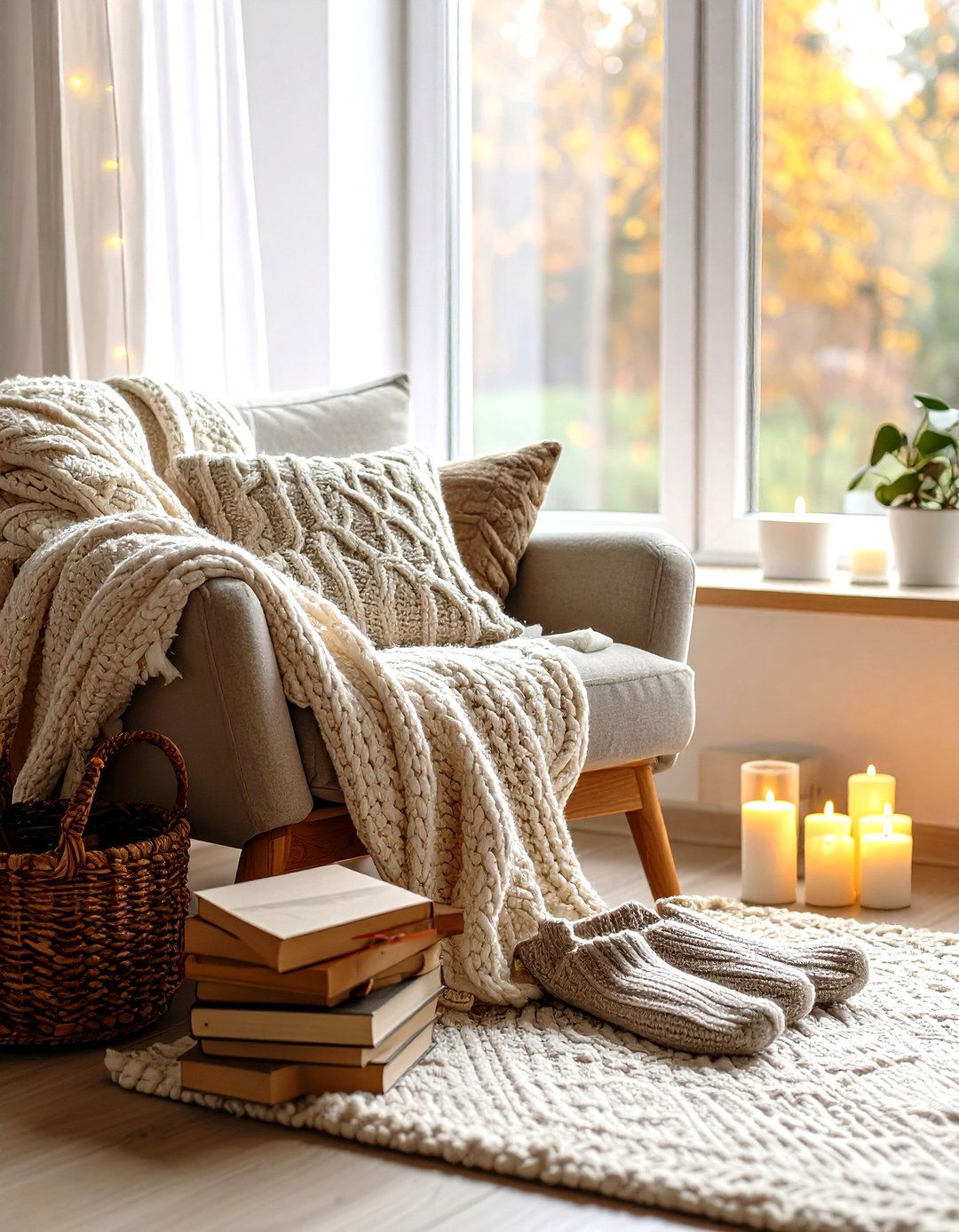


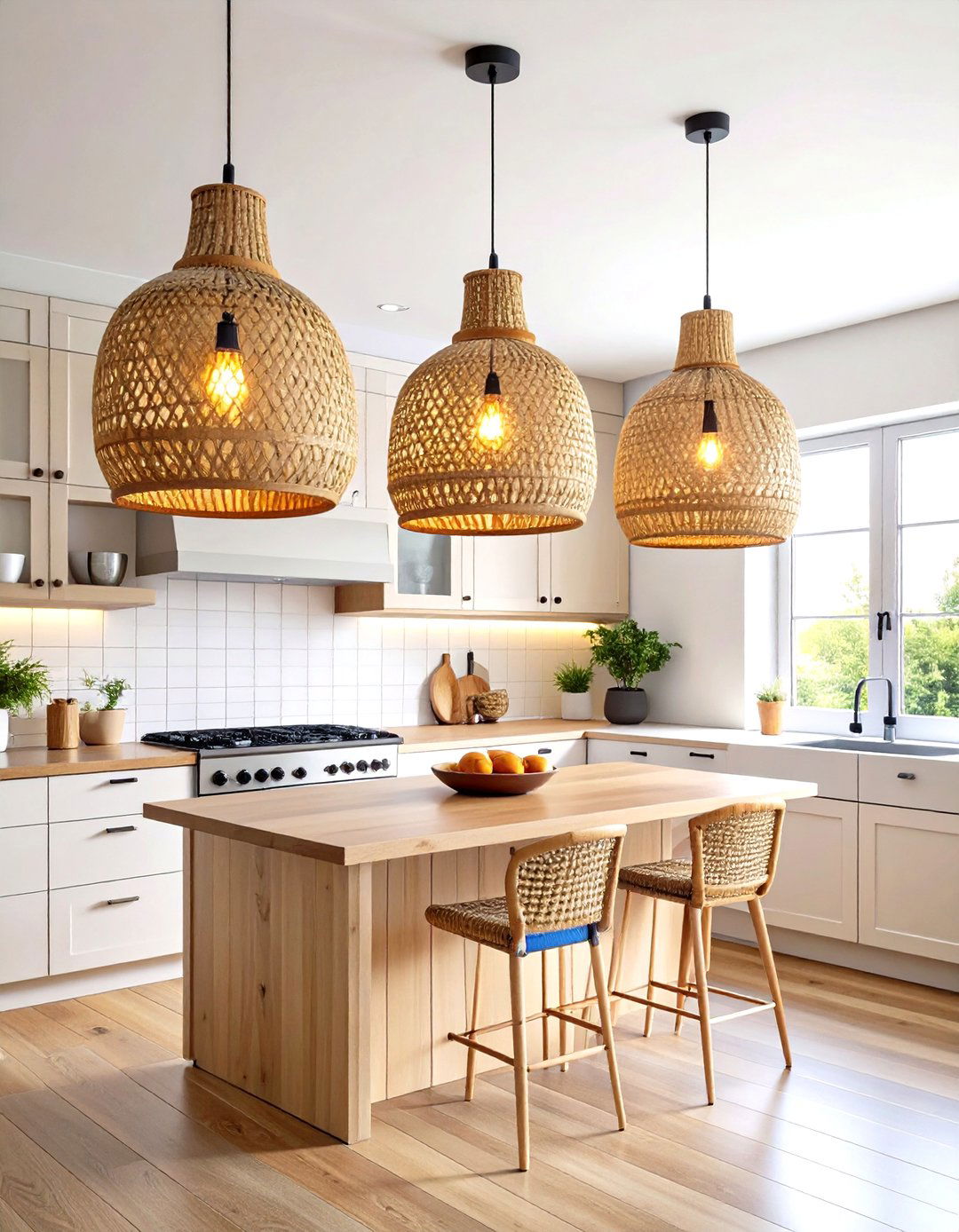

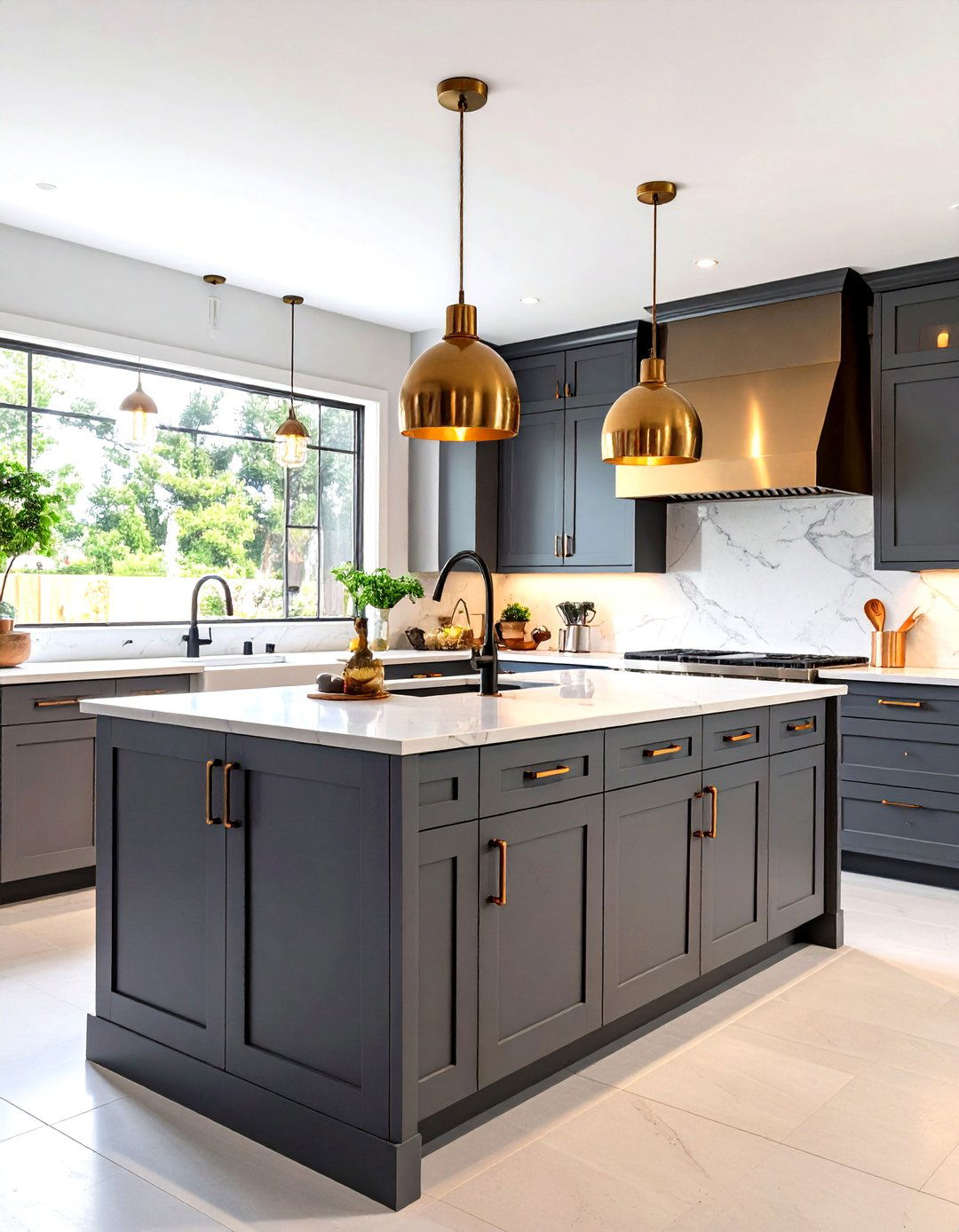
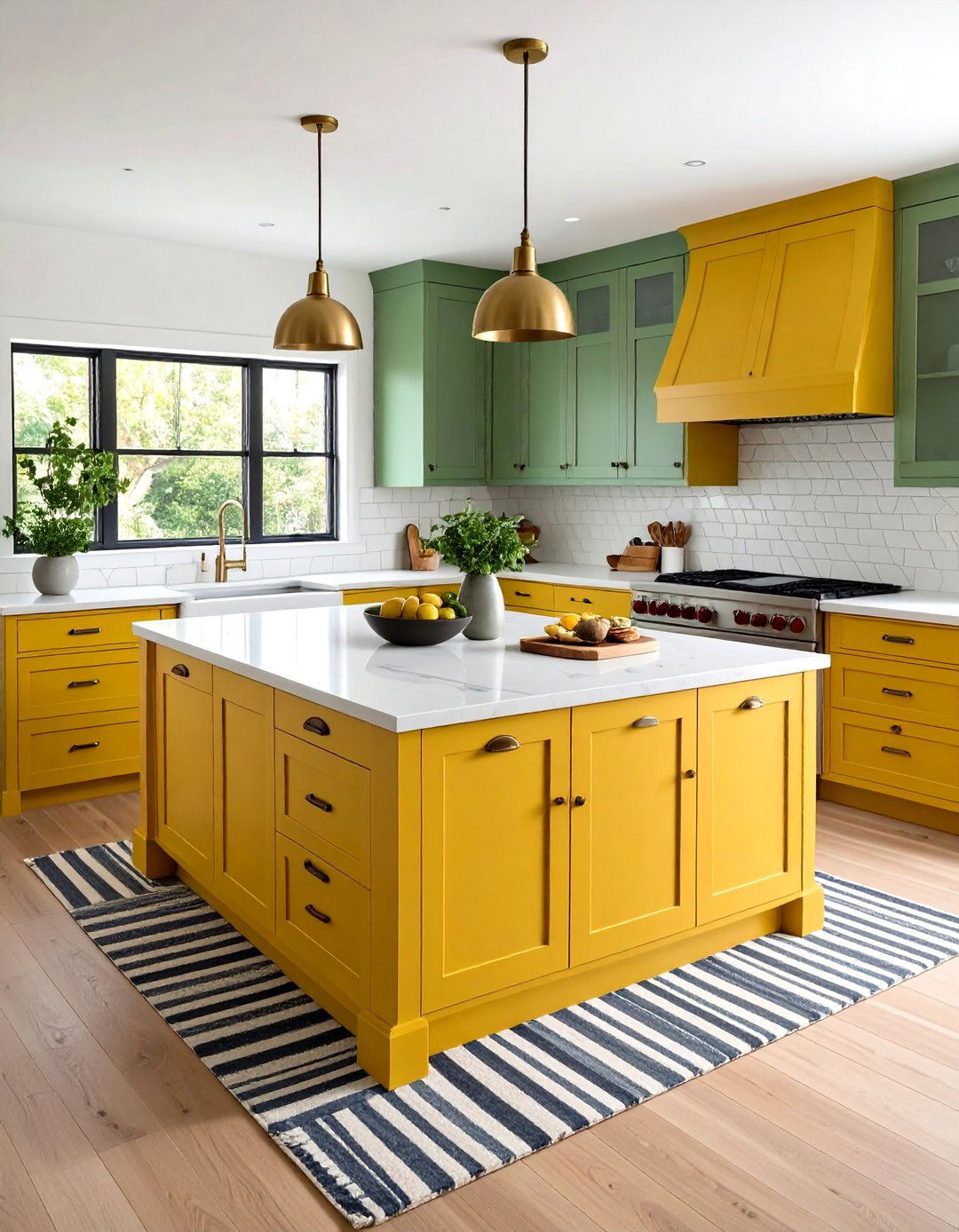
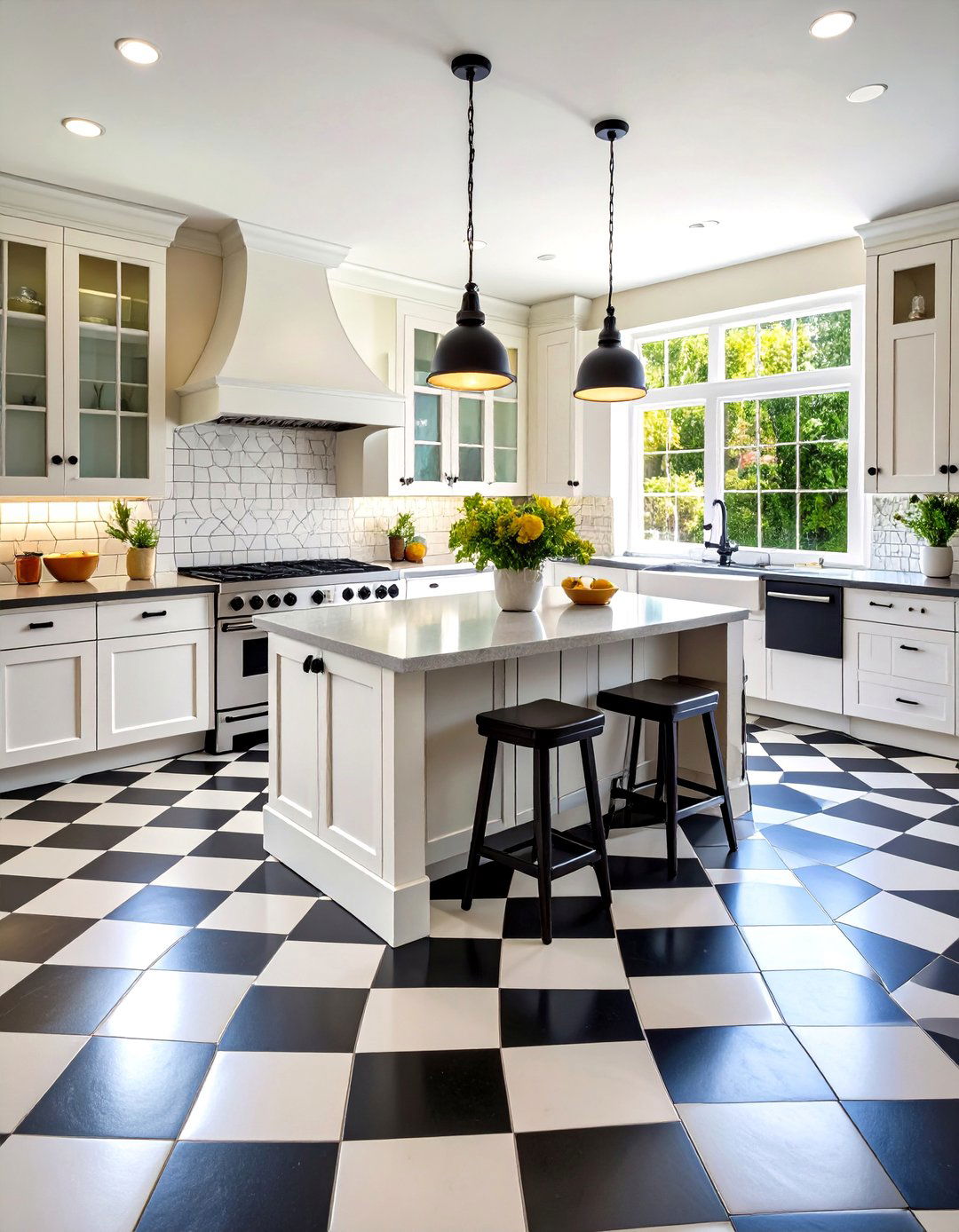
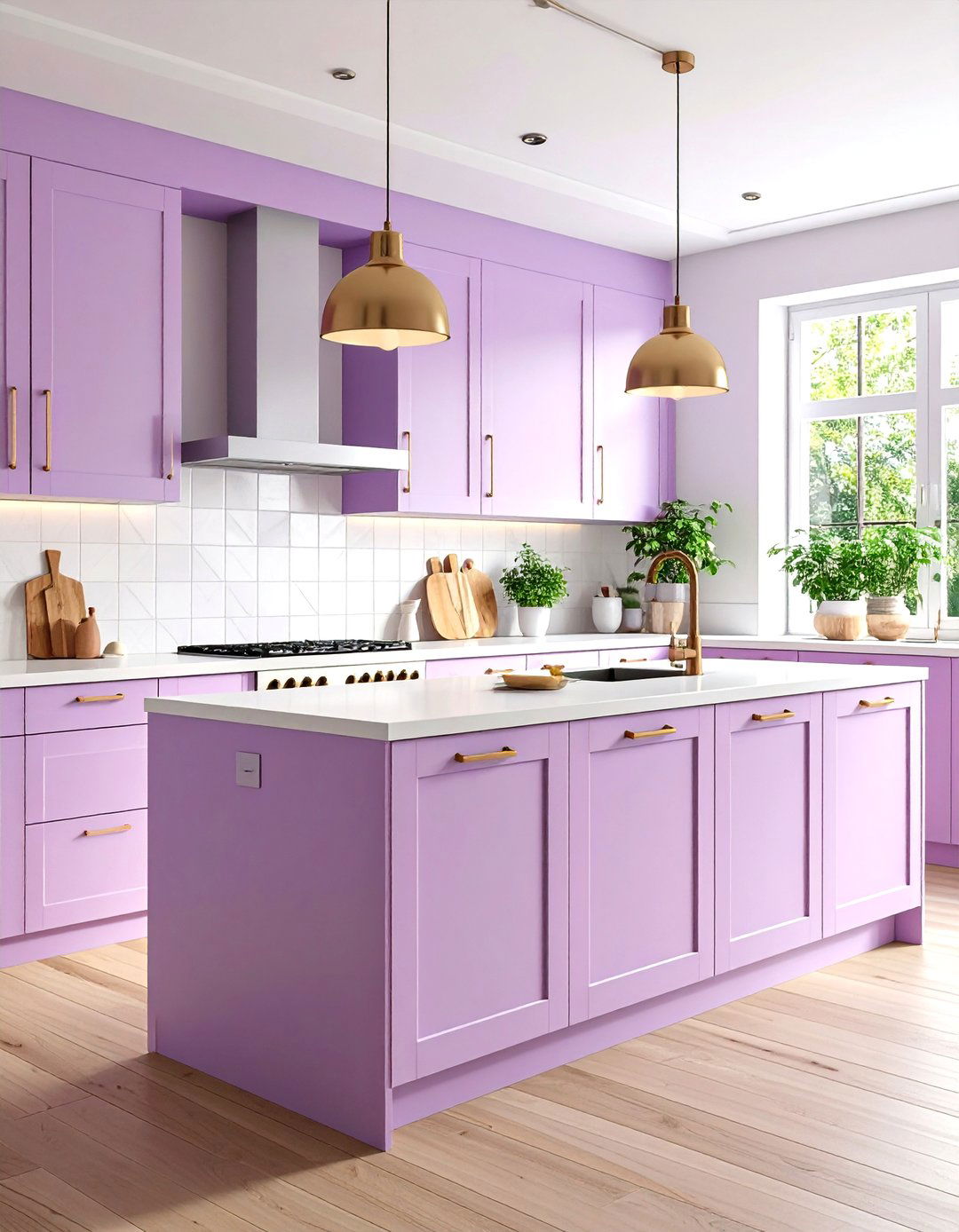

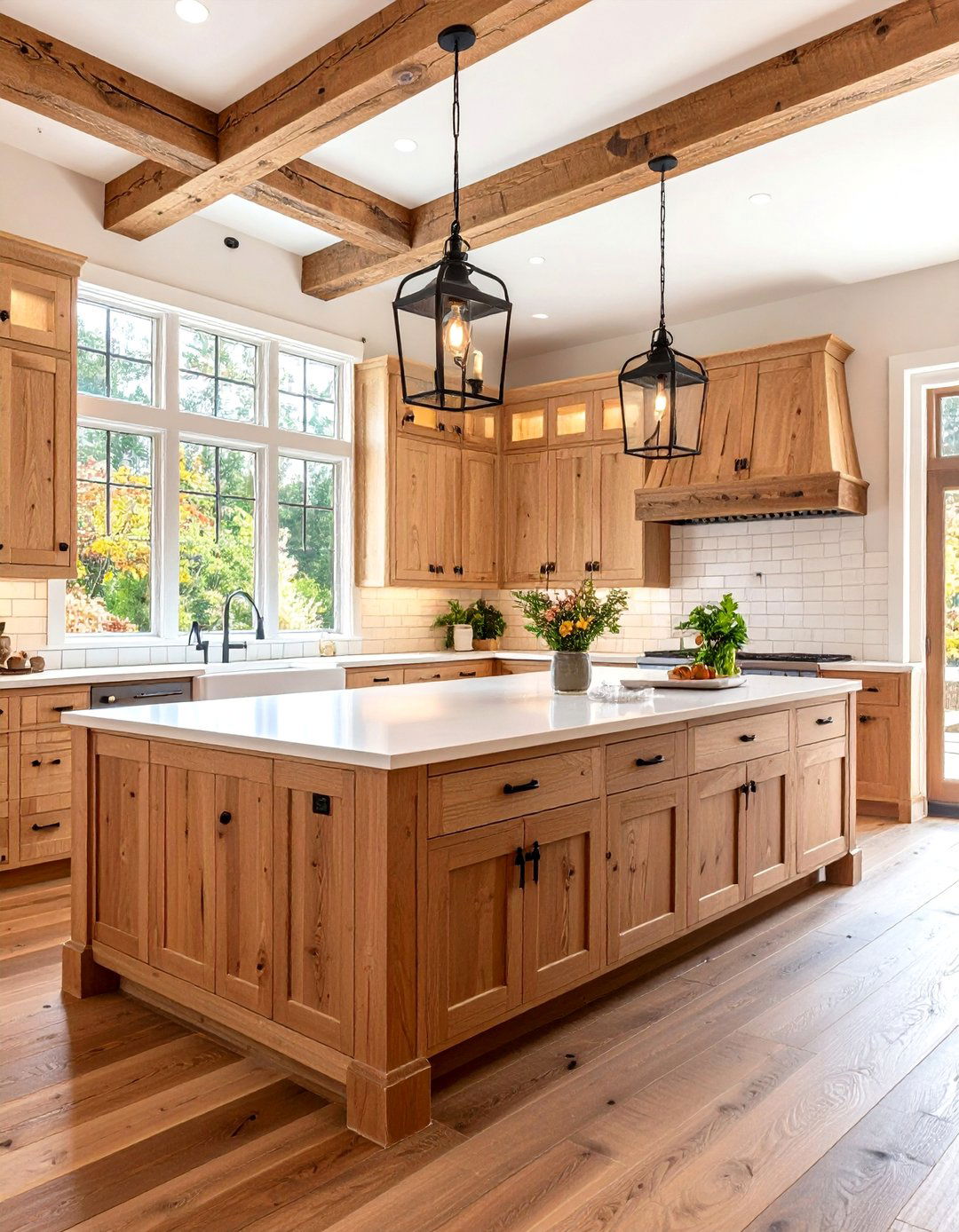

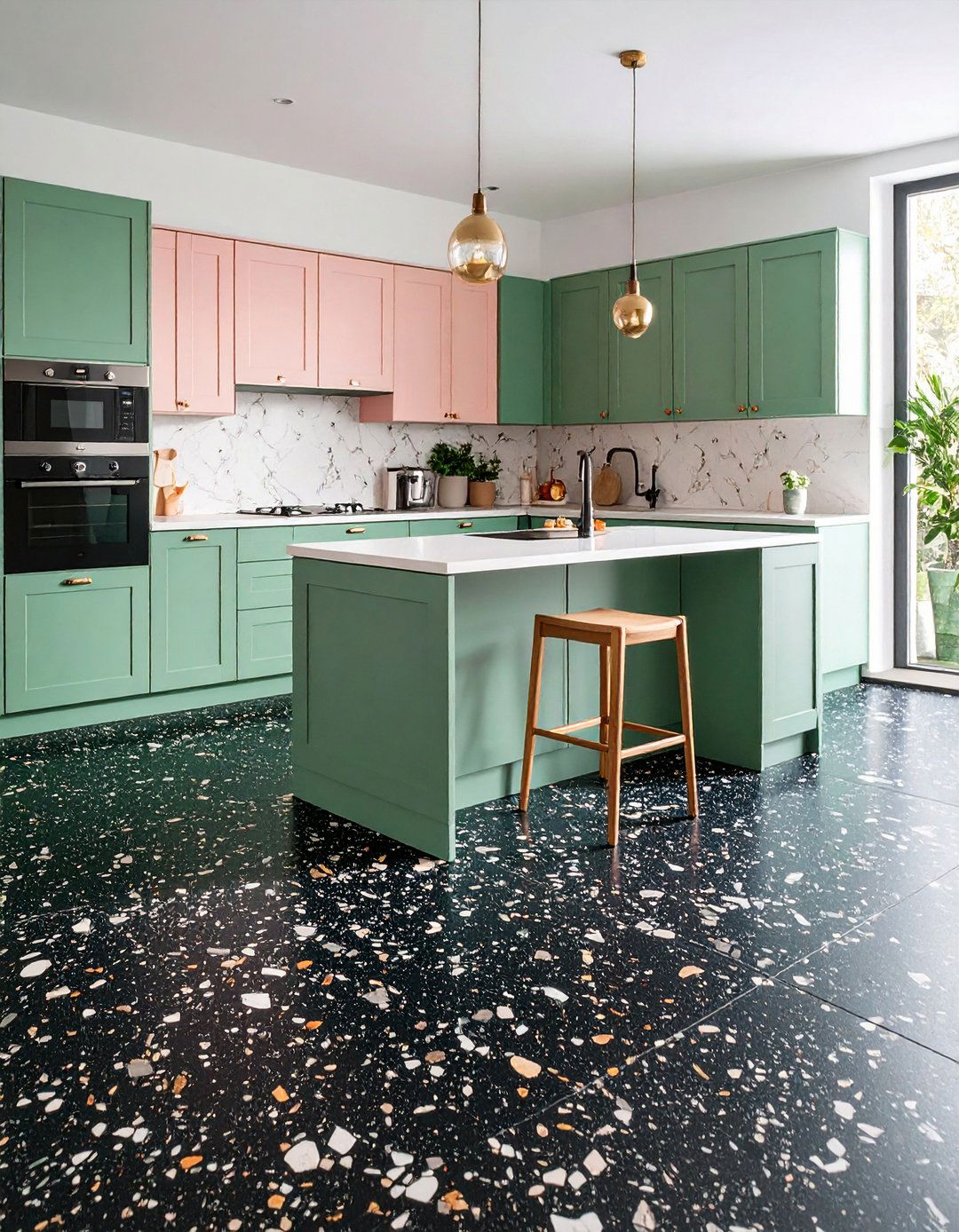
Leave a Reply